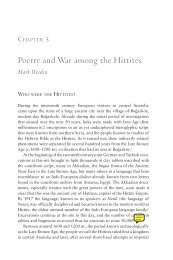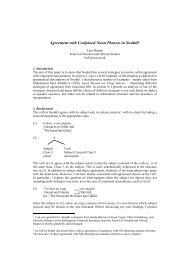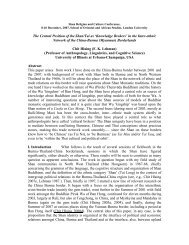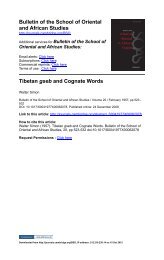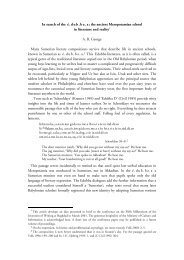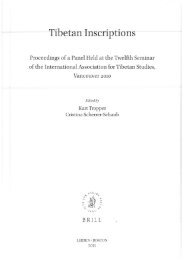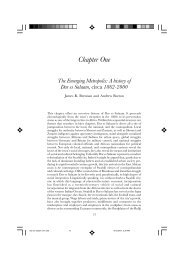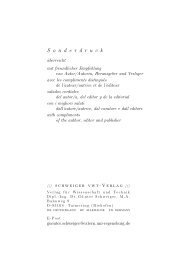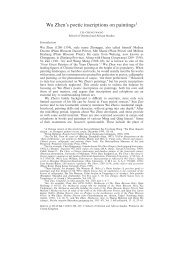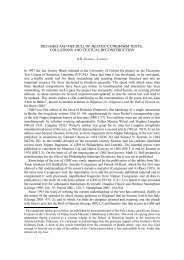000_JLC3_debut_FL - SOAS Research Online
000_JLC3_debut_FL - SOAS Research Online
000_JLC3_debut_FL - SOAS Research Online
Create successful ePaper yourself
Turn your PDF publications into a flip-book with our unique Google optimized e-Paper software.
2 Friederike Lüpke<br />
role in the most common multilingual repertoires, contrarily to their visibility, status and<br />
representation in research.<br />
2. The importance of language contact for linguistic structure<br />
Multilingualism of the kind encountered in West Africa entails intense language contact,<br />
mainly between African languages. Contact between languages is an important contributor to<br />
language change through the transfer of linguistic material (forms, meanings, and formmeaning<br />
associations) from one language to the other (Heine and Kuteva 2005; Matras 2009;<br />
Myers-Scotton 2002; Romaine 1989; Thomason and Kaufman 1988; Thomason 2001;<br />
Weinreich 1953). The intense type of contact present in the area is generally predicted to<br />
result in pervasive lexical and structural borrowings that affect all areas of language, but the<br />
extent and limits of structural interferences, in particular, are contentious (see e.g. Thomason<br />
(2001) pace Mous (2003) on the borrowability of noun classes). However, multilingualism<br />
and in language contact between African languages is dramatically underresearched.<br />
Therefore, despite a general awareness of the area as one of great linguistic and cultural<br />
convergence and the existence of a number of important studies on sociolinguistic profiles<br />
(Dreyfus and Juillard 2007; Juillard 1995), language attitudes (e.g. Canut 1996; Dumestre<br />
1994) and code-switching (e.g. Haust 1995), little is known about the linguistic consequences<br />
of specific contact scenarios, and even less about contrasting scenarios involving the same<br />
languages. The scarce existing studies on contact phenomena between individual languages<br />
(e.g. Beyer 2006, 2009; Dombrowsky-Hahn 1999; Drolc 2005; Nicolaï 2005; Turay 1978)<br />
point to considerable structural parallelisms permeating all areas of grammar, as is to be<br />
expected in situations of intense and extended contact, but also suggest that the direction of<br />
contact-induced influence can be the opposite of sociolinguistic factors attested elsewhere or<br />
exhibit no clear directionality or straightforward correlation with social factors altogether.<br />
Deplorably, however, these data on linguistic interferences often cannot be meaningfully<br />
interpreted, since, in general, studies on multilingualism are not directly associated with the<br />
description and documentation of the languages in question. In the absence of detailed<br />
descriptions and documentary corpora of the languages in contact, coupled with detailed<br />
sociolinguistic information, it is almost impossible to establish whether convergences<br />
between them are due to universal constraints on linguistic structure, to a shared genealogy, to<br />
parallel yet independent innovations, to chance, or to contact-induced interferences. Despite<br />
the fact that West African languages are almost exclusively spoken in multilingual speech<br />
communities, descriptive and documentary efforts generally focus on one language,<br />
regardless of the linguistic profile of the speech community, and do not systematically include<br />
variations in language use, whether the latter involve the choice of language(s), dialects,<br />
styles or registers.<br />
3. The importance of language contact for language change<br />
The dominant research focus within African descriptive linguistics has been on languageinternal<br />
factors for change, and genetic relationships between languages (but see Heine and<br />
Kuteva 2005 for a notable exception). To date, our understanding of the internal relationships<br />
within the major subgroups of Niger-Congo, as in the case of the Atlantic languages, and their<br />
position within the phylum, as in the case of Mande, is limited. The exact genetic affiliations<br />
of Dogon and Songhay, for instance, remain a matter of dispute, (Dimmendaal 2008; Nicolaï<br />
2005). To give only one example, for Mande languages, recent classifications based on shared<br />
lexical innovations (Kastenholz 1996) and phonological characteristics (Schreiber 2008)<br />
come to partly conflicting conclusions, but there are huge gaps in the data due to the lack or<br />
paucity of descriptions. The position of Mande as a whole within Niger-Congo is odd, given<br />
the absence of ‘prototypical’ Niger-Congo features such as noun classes (but see Vydrin<br />
(1989) for an analysis that comes up with traces of noun classes in Mande languages).<br />
Regarding Atlantic languages, only one detailed comparative study exists to date (Sapir<br />
1971), and newer studies (Podzniakov 2007; Wilson 1989) go so far as to question the<br />
Journal of language contact – THEMA 3 (2010)<br />
www. jlc-journal.org



